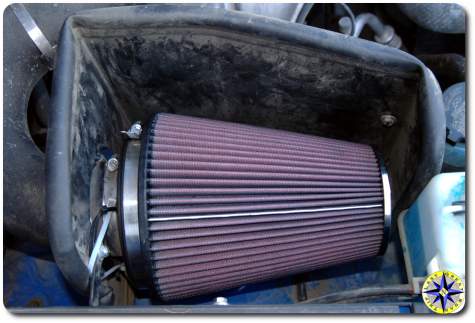We all get excited by our new mods and tell everyone we know how its the best (fill in product name here) on the market and we explain all the reason we choose product X. But over time does that glowing praise fad, or are you still pleased with your purchase? This report follows a year of use in all sorts of off-road adventure conditions, and reflects our real world experience with the K&N CAI for the the Toyota FJ Cruiser.
We replace the Toyota FJ Cruiser’s stock air intake with a K&N cold air intake (CAI) about 30,000 miles ago. The decision to make this mod was based on the horse power gain claims and our desire to beat the dust and debris associated with the dirt and gravel roads of expedition travel. We picked up the K&N model 63-9030 cold air intake for the Toyota 4.0L engine.
K&N states “our 63 Series Intake Kits or AirCharger® Intakes are built for many different vehicles and represent a dramatic improvement over a K&N O/E replacement filter alone. These intakes use only non-metallic rotationally molded tubes that can reduce intake air temperature and decrease intake sound over a metal tube. Restriction can exist BETWEEN an air filter and the engine reducing the benefit of a K&N Air Filter. The weakest link in the airflow ‘chain’ robs a vehicle of its natural horsepower. Often that weak point is the factory air path leading to the Engine. K&N Air Intake Kits virtually eliminate air path restriction by replacing the air filter and the entire air path to the engine. The aerodynamically engineered tube drives a massive amount of air into an engine, which translates into POWER.”
According to K&N we should have seen a horse power increase of 11.95hp @ 4785rpm (K&N intake kits dynojet research). And while our rig was not put on a Dyno to validate the increase we felt a gain and certainly heard the throaty sound of air rushing in.
The installation is simple for anyone who has changed their own oil or replaced a stock air filter. The kit came with all the parts and easy to follow instructions. The bigger, and I do mean bigger, air filter is washable and reusable allowing you to save money on filter replacements and increase air flow.
K&N states “All filters are constructed with ultra-strong molded pliable rubber flanges which absorb vibration and allow for secure attachment” and this is where we saw a major problem. The weight of the air filter hanging off the intake mount combined with the vibration of the rig as we cruised over washboard back roads (200 to 500 miles a day of washboard gravel and dirt at speeds of 40 – 55 mph) caused the filter to rub against the rigs body. This rubbing caused the filter to wear a hole through its wire mess and polished off the rig’s paint and primer below. At one point the filter vibrated completely off the intake tube despite a adjustable screw-down band clamp that came with the CAI. We did manage to correct this problem with some zip ties that secure the intake tube to the heat shield, adding support for the filter and lowering the amount of vibration cause the heavy filter.
The other drawback we found is that although the K&N CAI comes with an air guard designed to shield it from the hot engine bay, it is less than an ideal fit. Unlike TRD’s CAI which encloses the air filter and draw cool air from the outside, K&N’s is much more open with hot air flowing in from around, underneath and above the shield.
Bottom line, would we do it again… No! Although the K&N CAI works well enough, the lack of air control and the filters desire to jump off the intake tube led us to remove this K&N CAI.
All high flow air filters trade some filtration capability for more air flow. They try to solve it with oil spray or other dust attraction. The oil sprayed onto this type of filter has been blamed for muck on the MAF (mass airflow) sensor so use it sparingly according to directions. For now we will go back to the original stock configuration. For us the additional horse power claim from added air flow was not worth the trade off of filtration and added headaches.

